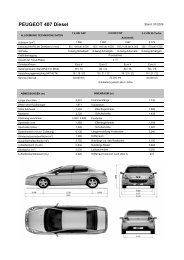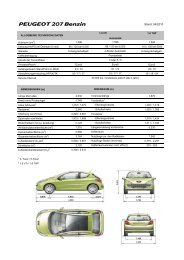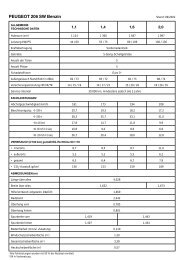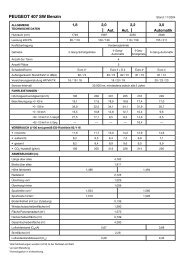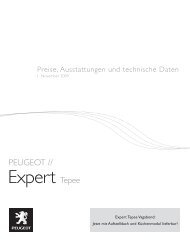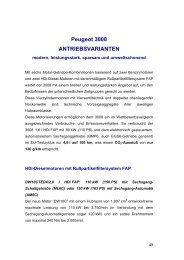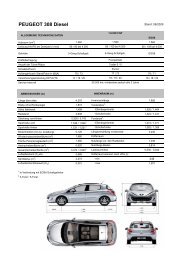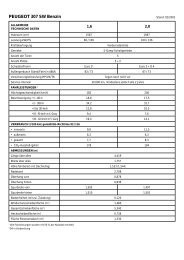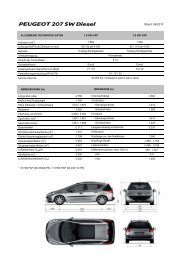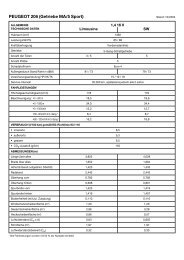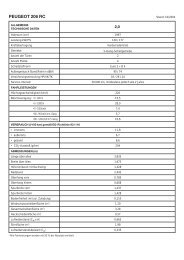PSA COUV page . page RA GB - PEUGEOT Presse
PSA COUV page . page RA GB - PEUGEOT Presse
PSA COUV page . page RA GB - PEUGEOT Presse
Create successful ePaper yourself
Turn your PDF publications into a flip-book with our unique Google optimized e-Paper software.
Growth Strategy<br />
Corporate<br />
Governance<br />
Business Review<br />
Corporate Policies<br />
Management’s<br />
Discussion<br />
and Analysis<br />
Statistics<br />
THE GROUP’S PRODUCT ST<strong>RA</strong>TEGY<br />
<strong>PSA</strong> Peugeot Citroën’s strategy is product-driven. As such, it is supported by frequent new model<br />
introductions that enable the Peugeot and Citroën marques to rapidly renew their core lineups and<br />
to continually have a large number of models positioned early on the growth curve. In addition, the<br />
marques are constantly developing new, architecturally and technologically innovative automobile<br />
concepts, boldly styled and capable of attracting new customers. Compelling examples of this vision<br />
include the Peugeot 206CC, the Citroën C3 Pluriel and the Peugeot 307 SW.<br />
To drive the harmonious development of Peugeot, Citroën and their model lineups in each of the<br />
Group’s market segments, the two marques stagger their launches in a given segment. This ongoing,<br />
balanced product development process enables the marques to attract an ever expanding customer base,<br />
continually refresh their offer and attenuate the impact of model life cycles on consolidated results.<br />
STRONG <strong>PEUGEOT</strong> 307 SW<br />
SALES PROMPT FOURTH<br />
SHIFT AT SOCHAUX PLANT<br />
In response to stronger-thanexpected<br />
sales of the new SW<br />
version of the Peugeot 307, the<br />
Sochaux plant introduced a fourth<br />
weekend shift in October 2002.<br />
Every week, the new team builds an<br />
additional 1,400 Peugeot 307s,<br />
raising total weekly output to 12,500<br />
units. The increase will enable the<br />
marque to meet demand and<br />
achieve its target of selling 600,000<br />
units in 2003.<br />
• Diesel engines and the particle filter<br />
European demand for diesel-powered cars<br />
and light commercial vehicles continued<br />
its strong upward trend in 2002. In<br />
response, the Group’s high-pressure, direct<br />
injection (HDI) diesel powerplants were<br />
extended across almost the entire Peugeot<br />
and Citroën lineup. More than 1.3 million<br />
HDI-powered vehicles were sold during<br />
the year, a 30% increase over 2001. In all,<br />
diesels accounted for 49% of consolidated<br />
sales, while registrations of diesel-powered<br />
Peugeots and Citroëns rose 9.5% in Europe,<br />
for a combined regional market share of<br />
nearly 19%. <strong>PSA</strong> Peugeot Citroën remains<br />
the only carmaker to equip its diesel<br />
engines with a particle filter, an innovation<br />
that makes them much more environmentally<br />
friendly. The particle filter is now available<br />
on the Citroën C5 and C8 and the Peugeot<br />
307, 406, 607 and 807. By year-end 2002,<br />
nearly 400,000 Group vehicles had been<br />
fitted with the new technology.<br />
THE PLATFORM ST<strong>RA</strong>TEGY<br />
The Group pursued its platform strategy<br />
in 2002, with the objective of having<br />
common parts account for 60% of the<br />
cost of vehicles made on the same<br />
platform. The strategy is helping to lower<br />
production costs, reduce unit research<br />
and development expenses, keep capital<br />
expenditure under control and shorten<br />
time-to-market cycles. It entered a new<br />
phase in 2002, when all three new<br />
platforms were successfully deployed, but<br />
nearly half of the resulting economic<br />
impact has yet to be felt. As new models<br />
based on the common platforms are<br />
introduced, the Group expects to generate<br />
some €800 million in additional savings<br />
between 2002 and 2006.<br />
A MANUFACTURING BASE SIZED FOR<br />
GROWTH<br />
<strong>PSA</strong> Peugeot Citroën has world-class<br />
manufacturing facilities, whose capacity<br />
was extensively used in 2002. According<br />
to the Harbour index, which measures a<br />
plant’s utilization based on hourly capacity,<br />
an average 16-hour workday, and 235<br />
workdays a year, assembly capacity<br />
utilization in Western Europe has risen<br />
steadily, from 76% in 1998 to 117% in<br />
2002. The latest rate reflects the growth<br />
in unit output as plant operating hours<br />
have been extended with new production<br />
schedules. All of the European plants are<br />
now working partially or entirely in three<br />
or four shifts, while the non-stop<br />
production system, without any summer<br />
shutdown, remained in effect at the<br />
Mulhouse, Ryton and Vigo plants.<br />
Assertively engaged in a long-term growth<br />
dynamic, the Group intends to produce<br />
more than four million vehicles in 2006,<br />
after increasing sales by 55% from 1998<br />
to 2002. To secure an optimum balance<br />
between high capacity utilization and the<br />
resulting technical, financial and laborrelated<br />
constraints, the Group has decided<br />
to build a new assembly plant in Trnava,<br />
<strong>PSA</strong> <strong>PEUGEOT</strong> CITROËN - MANAGING BOARD REPORT 39




